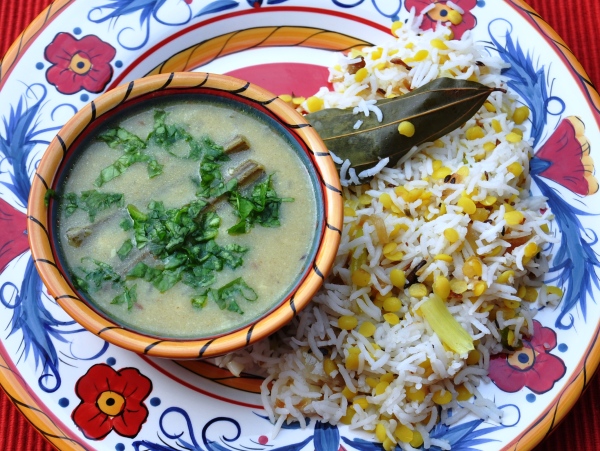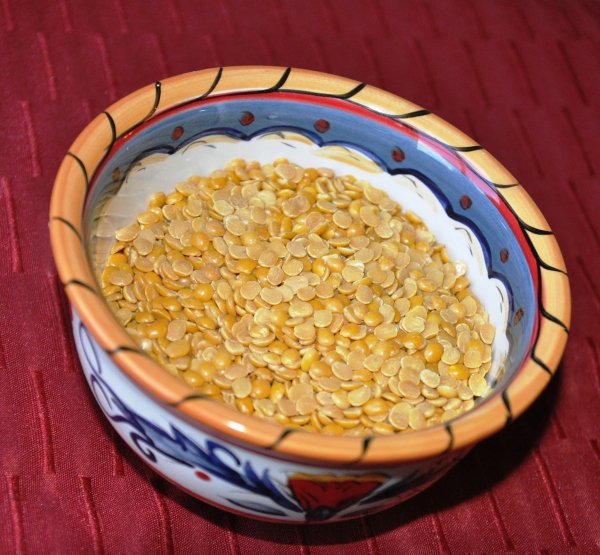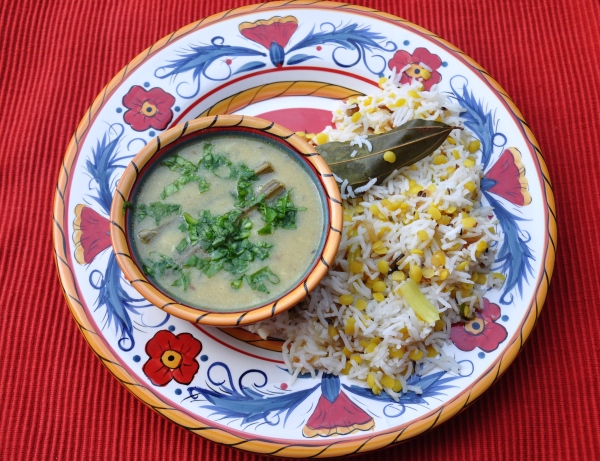Guest Post: Dal Chawal Palidu – A Bohra Muslim delicacy
Today on OneLifeToEat, Farida guest blogs her recipe for a Bohra Muslim favorite, Dal Chawal Palidu. Farida & I went to the same school and our families know each other very closely. However, it was only after I connected with her when I moved to the US, that our friendship grew. Although the recipe for this mouth-watering dish is a little lengthy, the effort is totally worth it. What’s more, it’s all vegetarian! Try Farida’s recipe when you’re in the mood for some innovative Indian fare and you won’t be sorry.
Of all the dishes that mark the Dawoodi Bohra cuisine, if I had to pick one that is extremely unique and representative of our food, it would be Dal Chawal Palidu (Lentil rice served with a curry.) In most Bohra households, this dish typically signifies a happy occasion such as the start of the New Year or a birthday, so I have many special memories associated with it. And though I’m not too fond of vegetarian food, Dal Chawal Palidu (also known as khuddal palidu) has always been one of my favorite dishes – simple, nutritious and yet extremely delicious!
You Will Need (This recipe serves 4):
For the Dal Chawal (lentil rice)
- 1 cup toor dal (also known as toovar dal or split pigeon peas)
- 1.5 – 2 cups of rice
- 1 tsp turmeric powder (haldi)
- 4 cloves of garlic, chopped
- 5 whole black pepper corns
- 1 tsp whole cumin seeds
- 1-2 bay leaves
- 1” piece of cinnamon
- 1 small onion, chopped
- 2 medium-sized green chilies, chopped
- 2 tbsp oil
- Chopped scallions for garnishing (optional)
- Salt to taste
For the Palidu (curry)
- Leftover lentil/dal water (see method for details)
- 1 tsp methi (fenugreek seeds)
- 4 cloves of chopped garlic
- 1 small onion, chopped finely
- 4-5 curry leaves (optional)
- 2 tbsp besan or (gram flour or chickpea flour)
- ½ tsp red chili powder or according to taste
- ½ tsp turmeric powder
- 1 tsp coriander-cumin (Dhania Zeera) powder
- 3 tbsp oil
- Coriander (cilantro) for garnishing (optional)
- Drumsticks – 6-7 pieces, cut to 3” size each). As an alternative, you can also use a small or medium-sized bottle gourd (calabash) or dudhi (cut into small pieces.) I prefer drumsticks since it adds an interesting flavor and texture to the palidu or lentil curry. You can buy the drumsticks fresh or frozen (these come cleaned and chopped) from an Indian store.
Method
For the dal chawal
- Boil the toovar dal in water in a pan over a medium heat for around 10-12 minutes or until it is almost cooked, adding turmeric and some salt. (The dal should remain whole and not turn mushy.) Strain the water from the dal and keep it aside.
- Heat oil in a pan. Add the garlic, black peppers, cumin and bay leaves. Once they start crackling, add the chopped green chilies and onion. After the onion starts browning, remove the mixture from the heat and mix in the cooked toor dal and keep aside.
- Cook the rice until it is ¾th done and layer it over the cooked dal in a cooking pot. Add around ¼ cup of water, cover the pot with a lid and let the rice mixture steam on a low flame for 5 minutes. Cook until the rice is completely cooked.
- I like to garnish the dal-chawal mixture with some scallions though this is my personal preference and completely optional.
For the palidu
- Heat oil in a pan. Add the methi or fenugreek seeds, curry leaves, chopped garlic and onion. Once the onions soften, add turmeric, red chili powder and the coriander-cumin powder.
- Add besan (gram flour) to the mixture and sauté for two minutes on a medium flame, stirring continuously. Add little water, if necessary, to prevent the mixture from burning.
- Add the drumstick pieces and stir for another minute.
- Add the leftover dal/lentil water to the mixture and let the mixture boil slowly.
- Cook the palidu till it boils and the drumsticks are cooked (it should turn soft and fleshy from inside,) adding more water if necessary.
- Garnish the palidu with coriander (cilantro.)
Tip: You can add more besan to thicken the consistency if the palidu seems soupy.
The lentil and rice mixture must be eaten along with the palidu. Traditionally, this dish is served with some pappadums and pickle, adding some wonderful crunch and spicy tang to it. If you have any interesting variations to this dish or a different way of making it, please feel free to share your comments on this blog.






Hey Ladies!
Great job with the DCP. Looks great. And Farida love that kitchenware of urs 😉
I have my own theory on DCP -When a South Indian Bohra meets Gujarati Bohra DCP was born. I see it similar to South Indian curries and Gujarati Khichdi!
I make the chawal pretty much the same way. Except instead of adding onions with the tadka I add fried onions to the dal mixture towards the end.
As for the Palida I also add Kokum ( Dried mangosteen) if not a bit of amchur powder for sourness.
Another trick that I have caught along the way is to add chopped coriander to your warm dal water for sometime (basically till you are ready to use it ) . This gives a beautiful herbal flavor and intense green color to the palida.
Sabera sorry for stalking your space 😉 I talk way too much when it comes to food 🙂
Hey Farida, put some mint leaves too
in dal preparation to enhance the Taste 🙂
This looks really interesting Sabera. Now I’m feeing hungry despite just having had my lunch!
Thanks, Kulsum. I sort of agree with your theory. Palidu does come a little close to sambar, which also uses drumsticks and kokum as an ingredient. Since most of our famous dishes (Kari chawaal, biryani) involve meat, DCP really stands out as very different. It would be interesting to know how it really evolved. Thanks for the kokum tip. I know a lot of people add kokum to the palidu though I don’t. (I didn’t know it was also called ‘mangosteen!’)
Farida, this is such a great post. We’re a family of carnivores so we can definitely use more daal in our diet. I’m also glad to see daal in your rice- it’s like a healthier version of white rice! Bravo, friend! 🙂
hi there! just wanted to let you know that we featured this post on FoodPress.com today! Loved reading about the background of the dish and it looks delicious! Thank you!
Thanks Jane! Glad you liked the post. The Bohra Muslim cuisine is quite unique and mixes Arab and Indian cuisines in an interesting way.
The recipe article is great!!
Hi.. i followed your recipe but made a mistake! Instead of 1 tsp i added 1 table spoon of tumeric powder while boiling the dal.. the dal stock seems to smell like haldi water! is there any remedy to this now?
Thanks,
Jamila
Hi Jamila – unfortunately the taste of haldi is quite overpowering and I am unaware of any way to mask its flavor if you have added too much 🙂 Finish making the palidu as is and taste. If it has a strong taste of haldi, try masking it with lemon juice. Good luck!
hi,
When i was in school, i had a bohri friend who used to get awesome samosa’s as tiffin.
Would you be able to share the recipe of that? its not the one made with kheema but its a daal samosa(not mung though) with wheat flour cover. ( triangular in shape).
We stayed in northern maharashtra then..
thanks in advance.
Oh my GOD I found the recipe at last. Had lost my mom at an early age and didn’t knowhow she used to cook this magical dish.
Farida I am grateful to you for posting this online and keeping our legacy alive. God bless.
Glad the recipe brings back memories for you, Muslim. Would love your suggestions on other Bohra recipes I can blog about.
Hi! Loved your recipe, its been ages since I ate palida and dal chawal. I am sure my kids will enjoy this, thanks to you.
Glad you enjoyed the post, Shabnam. Let me know how it turns out when you make it for your kids!
Can you please tell me how to make DCP with mutton aka biryani style?
Hi Farida!! Was craving for DCP and what a pleasant surprise I came across your recipe online. Small world. Hugs, Prianka
I enjoyed making the Palidu. I added lemon, brown sugar, cilantro. Based on available ingredients, I used frozen edamame instead of drumsticks and corn flour instead of gram flour. Alas, I had no curry leaves. It was very tasty. I served it with khichadi.
Interesting take on it, Ajit! I must try it your way 🙂
Put some Mint leaves to dal preparation to enhance the taste 🙂
Loki must be included for thickening and nourashing purpos. do not use mint,but use celentro to enhance the taste.